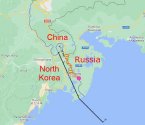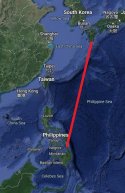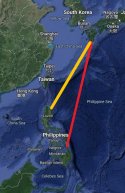After reading through, I generally agree more with
@Minm here.
Based on the present conventional military capabilities of North Korea and Russia, by having them participating in the China-US war over Taiwan now and in the near future would result in more of a liability than an asset for China. This is especially considering the losses suffered by Russian forces in the ongoing war in Ukraine, and the problems plaguing the Russian armed forces.
Meanwhile, I would refrain from putting the North Koreans on any level better than the Russians, TBH. Sure, both of them could throw punches, but whether they are capable of taking punches is an entirely different matter. Personally, I don't think Beijing would like to entertain a new front in the Korean Peninsular (plus the increased possibility of a third front, in case the Indians gets cocky as China's attention is directed at WestPac).
Therefore, I believe that it would be in Beijing's interests to keep Russia and North Korea out of direct participation in the war over Taiwan, unless the situation for the PLA is dire enough that the stakes for both Russia and North Korea would be significantly affected in order to warrant a direct intervention.
Despite the shortcomings of keeping Russia and North Korea from directly participating in the war over Taiwan, China can definitely utilize Russia and North Korea's military, geopolitical and geographical potentials to her advantage.
1. Keeping the Korean Peninsular stable:
The key here would be to keep South Korea from directly participating in the war against China on Taiwan.
That means North Korea will have to do its usual job and present itself as yet another significant enough threat, such that South Korea would rather allocate more effort into guarding against North Korea and minimizing their contribution to the Taiwanese separatists' cause. Doing large scale military exercises would be a good method. Russia's Eastern Military District and China's Northern Theater Command could also chip in and help North Korea by particpating in their military exercises as well.
However, care must be taken such that South Korea is not too agitated by the KPA's military actions, causing Seoul to falsely believe that going to war with Pyongyang and Beijing is worth the trouble. For that, Beijing should provide firm guarantee to Seoul that Pyongyang would keep its actions under control, and that neither side is looking forward to
restart resume the Korean War, in exchange for South Korea to not directly participate in the war and provide military assistance to Taiwan.
There is a fine line to balance here.
2. The China-North Korea-Russia airspace corridor:
The key here would be the triple-point narrow corridor (TPNC from now on) which I have outlined in the H-20 bomber (with H-XX, JH-XX) thread:

The corridor is less than 60 kilometers long, which can be travesed at high-subsonic speeds in less than 10 minutes.
To conduct reconnaisance, survillence and strike missions against targets in Japan, Chinese warplanes would only need to use this TPNC as a shortcut into the Sea of Japan, instead of having to circle around the Korean peninsular and risk interception by USAF and JASDF fighters from Kyushu and Shikoku.
Even if Pyongyang is unhappy with this kind of airspace intrusions by Chinese warplanes, what can they realistically do? China and Russia are the only countries keeping North Korea afloat by this point. There is nothing for Pyongyang to do but lodge diplomatic protest against Chinese warplane intrusions - But that's on the surface level.
Besides, the avenue where American and Japanese forces exploiting thie TPNC to attack targets deep inside China's Dongbei should be expected. Hence, for the under-the-table level, there is something which North Korea can assist China with. There are two options for Beijing and Pyongyang:
2a. North Korea should intercept any American and Japanese warplanes and missiles that are exploiting the TPNC:
This would save China some effort, as North Korea joins in with the defence of the China's northeast. In addition, China can also provide the KPAAF with fighters and SAM systems to do the job, on top of the ones they already own.
However, doing so could potentially rile up the Americans and Japanese, (and it wouldn't look good for North Korea on the international stage) such that Washington DC and Tokyo may choose to join forces with Seoul and invade North Korea in order to clear a path for them to launch direct assaults against China's Dongbei, hence reigniting the Korean War and forcing a second front upon Beijing.
2b. North Korea should not intercept any American and Japanese warplanes and missiles that are exploiting the TPNC:
This is a safer way to prevent the Americans and Japanese from finding justifications to attack North Korea, since Pyongyang isn't doing anything to stop their incursions into China as well. However, this would result in the task of intercepting American and Japanese warplanes and missiles be shouldered by the PLAAF and PLANAF stationed in the Northern Theater Command alone.
Despite having this demerit, there is something else which North Korea could make the jobs of the defending PLAAF and PLANAF units easier, which I will explain in the next point.
3. Intelligence gathering, information-sharing and early warning:
Firstly, back to the TPNC above the North Korean airspace.
Expecting that the American and Japanese forces would exploit the TPNC, Chinese fighters plus SAM systems would have to intercept them by themselves without any help from the KPAAF. However, China can provide air-search and early-warning radar sets to North Korea. These radar sets would be stationed inside North Korean territory, facing the direction of South Korea in the south and the Sea of Japan to the east. They would provide early warning to fighters and SAM systems stationed in the Dongbei to commence interception whenever American and Japanese warplanes and missiles are spotted flying towards the TPNC.
This is a small part of a larger, general idea which China could employ the help of North Korea and Russia for collecting intelligence from American and Japanese forces and movements based in the Sea of Japan, Honshu and Hokkaido.
The KPAAF has no such platforms, so they're totally out.
The VVS does operate a number of AWACS, SIGINT and ELINT aircrafts, which definitely can come in handy for the PLA. Since Russia isn't participating in the war, they can freely operate above the skies of Far Eastern Russia and over the Sea of Japan in order to monitor the distributions and movements of American and Japanese forces in the region and pass on the information to the PLA. But before any of these could happen effectively, joint PLAAF-VVS communication and integration between AWACS, ELINT and SINGINT units needs further work.
Despite this, I am not still entirely convinced by the VVS' capability in this - By looking at their rather limited deployments in the ongoing war in Ukraine. Perhaps China can "sell" a couple of WZ-7s and/or WZ-10s to Russia, have them painted in VVS colours, and fly them over the Sea of Japan using Russian crew oversight with Chinese personnel oversight from the ground in Russia.




